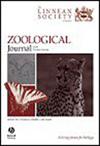An arboreal rhynchocephalian from the Late Jurassic of Germany, and the importance of the appendicular skeleton for ecomorphology in lepidosaurs
IF 2.8
2区 生物学
Q1 ZOOLOGY
引用次数: 0
Abstract
Here, we describe a new species of Jurassic rhynchocephalian from the Solnhofen Archipelago, Sphenodraco scandentis gen. et sp. nov., and highlight the importance of the postcranial anatomy for ecomorphological studies in the rhynchocephalian clade. The holotype of Sphenodraco scandentis is divided into a main slab, which has been mentioned in the literature and previously assigned to Homoeosaurus maximiliani, and a counterslab containing most of its skeletal remains. This new taxon shows an exclusive combination of osteological features that differs from previously described rhynchocephalians. Sphenodraco was recovered in our phylogenetic analysis as a component of a clade including Homoeosaurus and Kallimodon. To evaluate the ecomorphology of the new taxon, we compare fossil rhynchocephalians with the extant tuatara and squamates. We quantify the diversity of body proportions in lepidosaurs systematically, inferring lifestyle for extinct rhynchocephalians. Our analysis suggests that fossil rhynchocephalians had a diverse array of substrate uses, with some categorized as good climbers, and with Sphenodraco showing the extreme condition of limb elongation found in strictly arboreal lizards. This new taxon is here regarded as the first predominantly or even strictly arboreal rhynchocephalian. Furthermore, our analysis shows that the diversity of fossil rhynchocephalians might still be underestimated.来自德国晚侏罗世的一种树栖喙头类动物,以及鳞翅龙尾端骨骼对生态形态学的重要性
本文描述了一种来自索恩霍芬群岛的侏罗纪喙头类新种Sphenodraco scandentis gen. et sp. nov.,并强调了颅后解剖学对喙头类进化支系生态形态学研究的重要性。Sphenodraco scandentis的完整型被划分为一个主板,这在文献中被提到过,以前被指定为maximiliani Homoeosaurus,以及一个包含其大部分骨骼遗骸的底板。这个新的分类群显示出与先前描述的舌头类不同的独特的骨特征组合。在我们的系统发育分析中,蝶龙被恢复为包括异龙和卡利莫顿在内的一个分支的组成部分。为了评估新分类群的生态形态,我们将化石喙头类与现存的鳄目和有鳞目进行了比较。我们系统地量化了鳞翅龙身体比例的多样性,推断了已灭绝的喙头类动物的生活方式。我们的分析表明,喙头蜥化石具有多种基质用途,其中一些被归类为优秀的攀登者,而蝶蜥则显示出在严格的树栖蜥蜴中发现的四肢伸长的极端条件。这个新分类单元在这里被认为是第一个主要或甚至严格的树栖喙头类动物。此外,我们的分析表明,化石舌头动物的多样性可能仍然被低估了。
本文章由计算机程序翻译,如有差异,请以英文原文为准。
求助全文
约1分钟内获得全文
求助全文
来源期刊
CiteScore
6.50
自引率
10.70%
发文量
116
审稿时长
6-12 weeks
期刊介绍:
The Zoological Journal of the Linnean Society publishes papers on systematic and evolutionary zoology and comparative, functional and other studies where relevant to these areas. Studies of extinct as well as living animals are included. Reviews are also published; these may be invited by the Editorial Board, but uninvited reviews may also be considered. The Zoological Journal also has a wide circulation amongst zoologists and although narrowly specialized papers are not excluded, potential authors should bear that readership in mind.

 求助内容:
求助内容: 应助结果提醒方式:
应助结果提醒方式:


